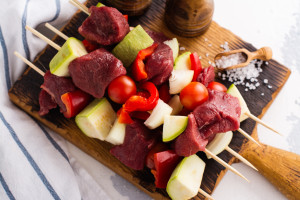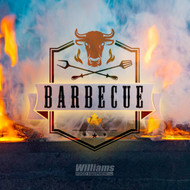Barbecue: Under the Smoke is the Savory Sensation!
2018 Jul 19th
It is July. Smoking time! We aren’t talking grilling as in burgers on a grate. Here, barbecue is BOSS. Slow smoked meats (corn is awesome also!), at specific temperatures, time, and wood, create one of the oldest, greatest, and most primitive techniques in the culinary world.
The word barbecue most likely comes from the way back days of Caribbean Natives in the 1700s. Barbacoa, as the Spaniards pronounced it from the cuisine learned, produced its name we now know, barbecue. This culinary preparation necessitates high heat and a grill or spit.
Barbecue, for our home chef purposes is prepared at 200-250 degrees. Needless to say, there are many, many approaches (And terms for em’..) of smoking, cooking, and grilling our foods. Might as well name the smoking temps and names for familiarity sake:
Cold Smoking is performed at 68 to 86 degrees. And is a dangerous proposition to try at home! Only cured meats should catch a little smoke from this method. And only commercial facilities should attempt this flavouring style. Your food can hang out for 24 to 48 hours in this environment. Most foods are heated up until hot and steamy, or 165 degrees to ensure no unwanted germs stick around.
When cooking at 77 to 104 degrees, you are Warm Smoking. Bacon and salmon go well under these conditions. Another temperature that is a bit volatile as a home chef.
We can all replicate a bit of barbecue with Liquid Smoke. Not saying it’s imitation, because it is just condensed smoke from water distillation. Invented in 1895, liquid smoke has gone through controversies, but still is around and used. Pyroligneous acid is now named as smoke flavour, condensed smoke, to name a few. Again, best used by the big companies doing sausages, etc.
Back on our theme of barbecue. The wood, the temp and the food are the three stars here. So…Lets get to all three!
The Wood:
Deciduous and hardwoods are the rulers of the pit. Fruit and nut woods impart the most well rounded flavours to your meats and veggies. But, here’s the crazy part. The soil, climate, the drying process, and a host of other conditions add to the intricacy of your selection of wood…Remember, wood contains lignin, carbon, oxygen, nitrogen, hemicellulose, hydrogen, cellulose, potassium, sulfur, sodium, chlorine and it goes on and on…Tress are alive and different. And burn at different heats at different stages. At top caloric speed, wood is burning at around 8500 British Thermal Units per pound. With this in mind, a good air dried wood of your choice, and proper temperature will still assure a noble banquet. The woods typically used are:
Alder: Sweet and good with fish and poultry.
Applewood: Fruity for pork and lighter proteins.
Cherry: Best for pork and beef. Great to add with other woods.
Hickory: Strong! Meant for beef!
Pecan: Maybe the most well-rounded wood. Burns at a lower temperature. Works well with all.
Maple: Ham anyone?
Mesquite: Watch out! The strongest of strong. A little smoke of the mighty Mesquite goes a long way. Strong is great for beef.
Oak: This is the longest burner. Use Oak for the super slow and low barbecue as it takes time for the flovour to settle in.
The Temps:
Slow and low is always the answer in barbecue. From lamb rack as low as 200 degrees. To pork butt that some say go as high as 250 degrees. Does degree matter? O Ya! Chemical reactions occur at differing heats. If in doubt, 230 degrees will be in the ball park for some tasty fixins’.
Truly, a great thermometer such as a Charcoal Companion - Steak Station Digital Meat Thermometer will ensure a crusty, darkened outside, with a moist, tender inside every time for every meat! At all times use safety in temperatures per the protein cooked. Prime Rib (an all-around fave), should never go over 125 degrees! Chicken, a bad night ensues for all at 125 degrees…Prepare your birds at 165 degrees to ensure it's fully cooked…This is why a great thermometer works. Place thermometer deep in the meat away from a bone, set the temp, and there ya’ go! Wait for the beep. You can prod and poke with your finger but that’s a guess vs reality with a thermometer. Be safe, keep your guests healthy and cook with knowledge, a thermometer!
The Meats & Veggies:
Well, obviously this is anyone’s choice. Beef brisket, chicken, and ribs are #1 around these parts. Bovines, swine, and poultry reign supreme around the globe. With this in mind, barbecue is of this Earth since man made fire. It is up to the Chef’s influences that construct the impeccable plate of barbecue he or she wishes. Vegetables, such as tators and corn take smoke astonishingly well. Squash, onion, bell peppers, and mushrooms dig on getting smoked when they can. Kebobs are easy to skewer and eat off the stick provided. Below is kebob recipe for entry into barbecue.
Experiment with your woods and foods. Soon, you will have the accurate amount of that delicious smoke to form that tasty barbecue we all crave! Dry rubs are an important component. And, there are many. From just salt and pepper, to a smorgasbord of who knows what, dry rubs layered on your protein of choice enable that smoke to fuse. The kebob dry rub is an accompaniment of the recipe.
 4 (8 oz.) cut into 1" cubes (16 pieces for four guests)
12 cherry tomatoes
2 red onions cut into 1" squares
12 mushrooms
3 red bell peppers cut into 1" squares
2 large zucchinis cut into 1" squares
1/2 cup olive oil
1/2 lemon squeezed for juice
1 teaspoon cumin
1 teaspoon garlic
1 teaspoon paprika
1/2 teaspoon allspice
1/2 teaspoon cardamom (equal parts nutmeg and cinnamon if you don't have this unique spice)
12 Metal Skewers for kebab preparation
Douse all ingredients in olive oil with juice of a lemon squeezed in. Layer on the skewer alternating each item. Now Sprinkle cumin, garlic, paprika, allspice, nutmeg and cardamom over all those delicious morsels.
Place in your barbecue until that digital meat thermometer reaches 120 degrees. Remove from barbie and wrap in foil for 10 minutes. Then, dig in! The vegetation will be mushy but tremendous!
Just one of millions of things to smoke! Remember, Temp, wood, duration matter! Place it in, leave it alone, and patience will be rewarded to those that wait. Enjoy - share with us your favorite barbecue.
4 (8 oz.) cut into 1" cubes (16 pieces for four guests)
12 cherry tomatoes
2 red onions cut into 1" squares
12 mushrooms
3 red bell peppers cut into 1" squares
2 large zucchinis cut into 1" squares
1/2 cup olive oil
1/2 lemon squeezed for juice
1 teaspoon cumin
1 teaspoon garlic
1 teaspoon paprika
1/2 teaspoon allspice
1/2 teaspoon cardamom (equal parts nutmeg and cinnamon if you don't have this unique spice)
12 Metal Skewers for kebab preparation
Douse all ingredients in olive oil with juice of a lemon squeezed in. Layer on the skewer alternating each item. Now Sprinkle cumin, garlic, paprika, allspice, nutmeg and cardamom over all those delicious morsels.
Place in your barbecue until that digital meat thermometer reaches 120 degrees. Remove from barbie and wrap in foil for 10 minutes. Then, dig in! The vegetation will be mushy but tremendous!
Just one of millions of things to smoke! Remember, Temp, wood, duration matter! Place it in, leave it alone, and patience will be rewarded to those that wait. Enjoy - share with us your favorite barbecue.
 4 (8 oz.) cut into 1" cubes (16 pieces for four guests)
12 cherry tomatoes
2 red onions cut into 1" squares
12 mushrooms
3 red bell peppers cut into 1" squares
2 large zucchinis cut into 1" squares
1/2 cup olive oil
1/2 lemon squeezed for juice
1 teaspoon cumin
1 teaspoon garlic
1 teaspoon paprika
1/2 teaspoon allspice
1/2 teaspoon cardamom (equal parts nutmeg and cinnamon if you don't have this unique spice)
12 Metal Skewers for kebab preparation
Douse all ingredients in olive oil with juice of a lemon squeezed in. Layer on the skewer alternating each item. Now Sprinkle cumin, garlic, paprika, allspice, nutmeg and cardamom over all those delicious morsels.
Place in your barbecue until that digital meat thermometer reaches 120 degrees. Remove from barbie and wrap in foil for 10 minutes. Then, dig in! The vegetation will be mushy but tremendous!
Just one of millions of things to smoke! Remember, Temp, wood, duration matter! Place it in, leave it alone, and patience will be rewarded to those that wait. Enjoy - share with us your favorite barbecue.
4 (8 oz.) cut into 1" cubes (16 pieces for four guests)
12 cherry tomatoes
2 red onions cut into 1" squares
12 mushrooms
3 red bell peppers cut into 1" squares
2 large zucchinis cut into 1" squares
1/2 cup olive oil
1/2 lemon squeezed for juice
1 teaspoon cumin
1 teaspoon garlic
1 teaspoon paprika
1/2 teaspoon allspice
1/2 teaspoon cardamom (equal parts nutmeg and cinnamon if you don't have this unique spice)
12 Metal Skewers for kebab preparation
Douse all ingredients in olive oil with juice of a lemon squeezed in. Layer on the skewer alternating each item. Now Sprinkle cumin, garlic, paprika, allspice, nutmeg and cardamom over all those delicious morsels.
Place in your barbecue until that digital meat thermometer reaches 120 degrees. Remove from barbie and wrap in foil for 10 minutes. Then, dig in! The vegetation will be mushy but tremendous!
Just one of millions of things to smoke! Remember, Temp, wood, duration matter! Place it in, leave it alone, and patience will be rewarded to those that wait. Enjoy - share with us your favorite barbecue.


